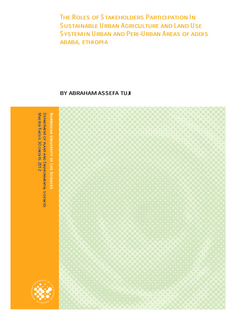| dc.description.abstract | Urban Agriculture (UA) has the potential for achieving, food sovereignty, food security, and increased quality of life for many people in Addis Ababa. However, urban farming is faced with many barriers such as lack of access to land, input and extension services that make it less productive. Moreover, Stakeholders have different perceptions and priorities for UA. The objective of this study was therefore, initiated to understand the problematic situations by analyzing and evaluating of the positions, interests, alliances, interactions and power relationships among key stakeholders, thereby, to understand their influences on UA and food systems in the study area. Data were collected using two open ended questionnaires. One was used to characterize the farming system together with selected district farmers, farmers’ cooperatives, and SMEs; the other was used for selected stakeholders’ analysis within the city. This study used five of the seven steps in SSM. Accordingly, step one and two would help to understand the problematic situations and expressing it with the help of a drawing a rich picture and SWOT analysis; step three and four would help in thinking about systems which may be used in the situation, including identifying root definitions and creating conceptual models of the system, whereas in step five the conceptual model was compared with the real world situations. Within the SSM framework, Stakeholders analysis and forcefield analysis were used as a major tools. From Stakeholders analysis, four main results were obtained, namely: identifying most important stakeholders; the stakeholders’ knowledge level; the stakeholders position to or against UA program; the stakeholders interest towards UA program; and which stakeholders might form alliances. Findings from the force field analysis indicated that: growth in industry & service sector, lack of land and temporary availability, urban planners and policy makers knowledge, lack of improved farm equipments, input access, farmers skill and knowledge, public health issues and market shade access as restraining forces for the success of UA in Addis Ababa. On the other hand, it was indicated that poverty reduction and food security initiatives, farmer’s motivation, market availability, employment needs and available labour force, were the major driving forces. Four Urban farming practices such as horticulture, small scale dairy, small scale egg chicken production, mixed crop-livestock and the land use scenarios were identified and described for action. | no_NO |
